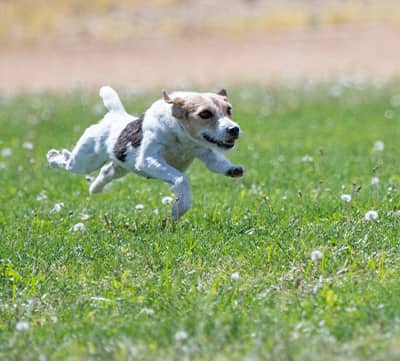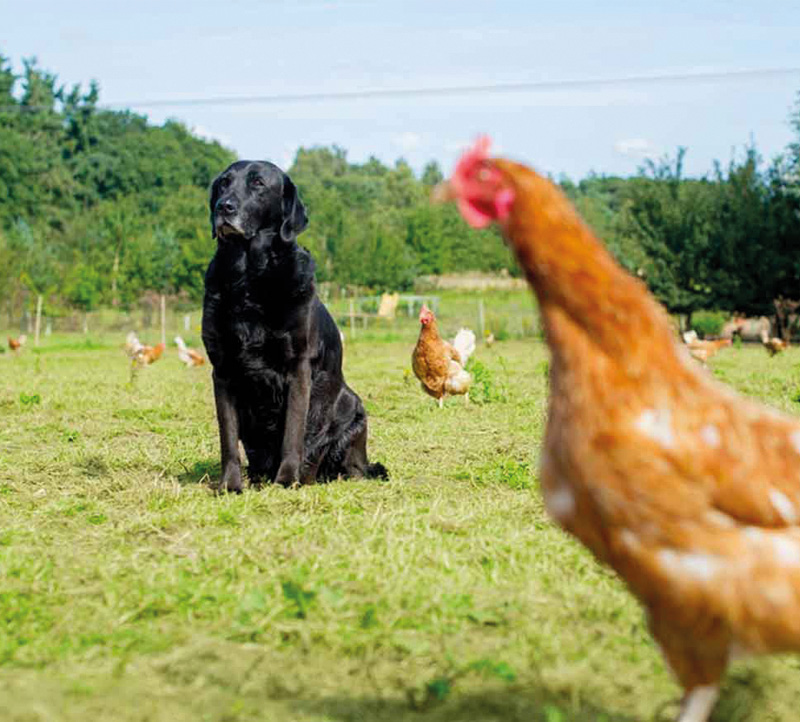Raw feeding in relation to common internal conditions in dogs
Quick links to specific conditions covered in this article:
- Addison’s disease
- Cushing’s syndrome
- Diabetes mellitus
- Exocrine pancreatic insufficiency
- Hepatitis (liver disease)
- Impacted anal glands
- Kidney disease (renal failure)
- Liver shunt
- Pancreatitis
- Kidney stones and other purine problems
- The thyroid gland
Mostly raw
With one or two exceptions (primarily where the dog’s immune system has been compromised), you will see that a raw food diet is always recommended. This is because raw food is the easiest thing for your dog to digest and supports his or her immune system.
Where raw feeding isn’t recommended, you should not revert to processed food but simply cook the ingredients in the way prescribed.
Processed food is an underlying cause for as many as 9 out of 10 visits to the vet, and this includes expensive, so-called scientifically developed, brands.
A reminder about water
Water is treated with a great number of chemicals. Ill dogs are less tolerant of these chemicals, and so it is advisable to find a source of pure, clean water.
This could be a mineral water (better from a glass bottle than plastic as plastic bottles left in the sun alter the chemical composition of their contents), rainwater or filtered water.
Why ill dogs do better on organic food
Intensively reared meat and intensively farmed vegetables, especially those imported from outside Europe, are often grown without the regulatory framework we are used to, and may contain a surprisingly high percentage of unnatural chemicals (everything from growth hormones to nitrates and from steroids to pesticides). Furthermore, meat will include the residue of whatever the animal has been fed.
This is particularly relevant in the case of grain-fed livestock and poultry, and grain is especially harmful to dogs. It is better, therefore, to feed organic food to ill dogs.
Addison’s disease
Addison’s disease is the opposite of Cushing’s syndrome in as much that the adrenal gland does not produce enough corticosteroid.
It can be a side effect of the drugs used to treat Cushing’s. It is less common than Cushing’s and can lead to other health issues.
The adrenal gland secretes several substances that help regulate normal bodily functions. Some of the most important products are glucocorticoids and mineralocorticoids. Glucocorticoids such as cortisol have an effect on sugar, fat and protein metabolism.
Mineralocorticoids such as aldosterone help to regulate blood pressure and allow the kidneys to maintain a proper water–salt balance in the body (by helping the kidneys retain sodium and excrete potassium).
If the adrenal glands are not functioning properly, and the production level of aldosterone drops, a drop in blood pressure and severe dehydration can occur. Dysfunctioning adrenal glands are the main cause of Addison’s disease.
Symptoms include muscle weakness and general lethargy, diarrhoea and vomiting, hyperpigmentation, joint pain, lack of appetite and muscle shivers and tremors. The usual treatment is hormone replacement with drugs such as fludrocortisone.
Diet should be under veterinary supervision. Changes in the health of the patient may require a change of diet and this will only be known if blood is monitored. Avoid vegetables and other foods high in vitamin A (such as carrots, celery and liver), also foods high in potassium (bananas, most meats but especially pork). Raw chicken or turkey are excellent as they have lower potassium levels.
Salt will generally have to be added to the diet, but this will depend on the blood analysis. Fresh adrenal gland in the diet can be beneficial as can dehydrated adrenal gland as a supplement.
It is important that the patient is not stressed. Some herbal and homeopathic remedies can help to achieve this. Patients may also benefit from a small amount of quinoa or porridge – as well as chia seeds, cottage cheese, tuna, egg, sunflower or pumpkin seeds, raw walnuts and raw almonds. The most important thing is to stabilise salt levels and maintain sodium levels.
Cushing’s syndrome
Cushing’s syndrome is an enlargement of the adrenal glands resulting in increased production of adrenocortical hormones. Symptoms increase thirst, appetite and the need to urinate. With time the dog can develop a potbelly and an intolerance to exercise with some cases showing muscle spasms and difficulty bending their legs. The coat becomes dry, hairs fine and the skin thins.
Hair loss around the flanks and abdomen can spread to the legs, back and head. The diet has to be easy on the liver and help the thyroid gland.
High-fat diets should be avoided and the best recipes to follow are chicken with some offal, rabbit and chicken mixed together, venison or lean beef. In terms of vegetables carrot is excellent (for the beta carotene) and broccoli, garlic and grapefruit seed extract.
The best supplement to help the thyroid is kelp or a similar seaweed. For the liver add milk thistle and for the heart (patients are likely to suffer from raised cholesterol) add hawthorn. The addition of fresh adrenal gland and/or dehydrated gland powder can also help stabilise these cases.
The diet and supplements need to be changed radically should the patient slip from Cushing’s to Addison’s. Other supplements that will help patients with Cushing’s include vitamins A and D (cod liver oil), vitamin B6, folic acid, vitamin C, vitamin K, calcium, magnesium, potassium, selenium, brewer’s yeast and zinc. However, you should not add extra supplements to the diet without consulting a vet. Herbal and homeopathic vets have much to offer in the treatment.
Diabetes mellitus
Diabetes mellitus occurs when the pancreas doesn’t produce enough insulin or because cells do not respond to the insulin that is produced. Insulin is required for the body to efficiently use sugars, fats and proteins. The commonest symptoms are increased thirst and urination.
Although dogs with diabetes mellitus usually have a good appetite, there may be weight loss. Confusingly, some dogs become obese. In many cases cataracts (cloudy lenses in the eyes) may be the first sign that there is a problem.
This disease may occur in conjunction with Cushing’s syndrome, urinary tract infections, hypothyroidism, pancreatitis and cancer. The condition is usually diagnosed from a urine or blood test.
A natural raw food diet is excellent, but if you are changing the diet from a high-carbohydrate commercial diet the switch must be made under veterinary supervision. Carbohydrates and acidity are the two core issues for diabetics.
One of the reasons why commercial foods are not good for sufferers is that they usually contain urinary acidifiers. Urinary acidifiers can have the effect of complicating the acidosis most diabetics are already suffering from, and the carbohydrates in the diet just keep the problems coming.
If antibiotics are used as part of conventional treatment then prebiotics and probiotics are recommended. Other supplements that can help control the symptoms of diabetes mellitus include magnesium, fish oil, brewer’s yeast, zinc and copper supplements and barley grass powder.
Exocrine pancreatic insufficiency
Exocrine pancreatic insufficiency (EPI) is the inability to properly digest food due to a lack of digestive enzymes made by the pancreas. It affects German Shepherds more than any other breed (about two-thirds of cases). EPI is caused by a progressive loss of the pancreatic cells that make digestive enzymes. It is often not diagnosed until well advanced.
Symptoms include weight loss, poor hair coat, flatulence and a voracious appetite. Sufferers may also pass bulky, fatty stools. In terms of treatment there is every reason to continue raw feeding since this is the easiest food for your dog to digest.
The amount of fat consumed should be kept to a minimum: chicken and lean beef are both good. Avoid any food (including cooked vegetables such as carrots and peas) containing a high proportion of sugar as this forces the pancreas to work harder. Digestive enzymes and Tree Barks powder can help. It is important to make sure your dog has plenty of pure, clean water.
Liver disease (including Hepatitis)
The liver has five important functions, affecting circulation, excretion of waste products, metabolism, immunological defence and blood formation. There are two types of liver disease: primary and secondary. Primary is caused by a non- or sub-functioning liver; secondary is caused by some other condition, such as bacteria, viral parasites, poisons, toxins or tumours.
The most common symptoms associated with liver disease include loss of appetite, vomiting, abdominal pain, enlarged liver, jaundice, discoloured urine, oedema (swelling), weight loss, photosensitisation (skin disease related to sunlight), poor blood clotting, anaemia and a change in stools (either diarrhoea or constipation).
Once the cause has been treated, diet has an important role to play, especially in relation to the carbohydrate, fat, protein, vitamin and mineral content. Raw feeding is ideal. Avoid all dairy and stick to a low-fat diet.
Conventional treatment can lead to a compromised immune system, in which case food should be lightly cooked. If antibiotics have been used as part of the treatment then it is advisable to give your dog prebiotics and probiotics.
Impacted anal glands
Impacted anal glands are an extremely common problem for dogs. The glands are situated either side of the anus and discharge a foul-smelling liquid, which is used for marking territories. They are usually emptied by the passing of stools, or if the animal becomes frightened. If not emptied frequently they become impacted, which leads to infection and possibly an abscess being formed.
Many vets feel that the primary cause of this problem is processed dog food. If your dog licks under their tail a great deal, especially if it causes eczema, or if they drag their bottom along the ground, this could well be an anal gland problem. (However, the same symptoms could also be caused by worms.) One of the benefits of a natural diet incorporating bone is that it creates small, firm stools, which empty the anal glands as the dog excretes.
Kidney disease (renal failure)
Kidney disease (or renal failure) is fairly common in dogs, especially those reaching their senior years. It is one of the few conditions where we do not recommend 100% raw feeding. Instead, you should take the same ingredients and parboil with lots of water and extra vegetables (especially green vegetables).
The extra vegetables will reduce the level of animal protein. When cooking the meat, heat it until it changes colour and then leave it to finish cooking using its own heat.
A supplement called Udo’s Beyond Greens will help throughput and to balance out the urea. Add it once the food has cooled and is ready to serve so as not to destroy the nutrients. Where high blood pressure is an issue, test to see whether the calcium, magnesium, potassium and sodium are all in the middle of the normal range. If below this level, add supplements. Cod liver oil, zinc and magnesium are very important dietary additions for patients with high blood pressure. Solidago (also called goldenrods) can also be of assistance. See below for more about kidney stones and purine problems.
Liver shunt
The medical term for liver shunt is portosystemic shunt (PSS). A ‘shunt’ is a blood vessel that bypasses the liver rather than passing through it. Dogs can be born with the condition or it may be acquired. Small dogs are affected more than larger dogs. Diet has an important role to play in the treatment of liver shunt.
Normally, the liver removes ammonia from the bloodstream so when this isn’t happening it is important to stop the body from producing ammonia in the first place.
This can partly be achieved by a low-protein diet. Adding drugs like lactulose and ursodiol to the diet helps with this problem. Make sure the dog drinks plenty of water in order to avoid dehydration. A low-fat diet is best.
Homeopathic support for the liver can be very helpful and should be done under veterinary supervision. Low-potency organ support remedies such as Chelidonium, Carduus marianus, Taraxacum and Berberis are recommended. In some cases adding carbohydrate to the diet in the form of organic porridge oats soaked overnight in water can assist in reducing the protein percentage in the diet. Other suitable carbohydrate additions are polenta and brown rice.
Pancreatitis
The pancreas is a V-shaped organ located behind the stomach and the first section of the small intestine, known as the duodenum. It performs two main functions: it aids in the metabolism of sugar in the body through the production of insulin and is necessary for the digestion of food by producing pancreatic enzymes.
Inflammation of the pancreas is called pancreatitis.
The symptoms of the disease are a painful abdomen, abdominal distension, poor appetite, depression, dehydration, vomiting, diarrhoea and yellow, greasy stools.
The dog may also look ‘hunched up’.
There are various causes of pancreatitis, including certain medications, infections, metabolic disorders (high amounts of lipid or calcium in the blood), trauma and shock. Middle-aged dogs and dogs with diets high in fat and/or carbohydrates seem to be at most risk. It is thought that dogs who suffer from Cushing’s disease (hyperadrenocorticism), hyperthyroidism and diabetes may also be at risk. In terms of treatment there is every reason to continue raw feeding since this is the easiest food for your dog to digest.
The amount of fat consumed should be kept to a minimum: chicken and lean beef are both good.
Avoid any food (including vegetables such as cooked parsnips and cooked carrots) containing a high proportion of sugar, as this forces the pancreas to work harder.
If the pancreas is totally non-functional or very sub-functional, medical supplements such as enzyme replacements may be necessary. This can be done with conventional enzyme replacements (such as Tryplase or Creon 2000) or herbal supplements (such as Tree Barks Powder from Dorwest Herbs).
Patients may also need antibiotics or steroids as part of a conventional treatment. One problem with conventional treatment is that patients can become immunocompromised as a result of the steroids, meaning that they will be more susceptible to infection even from the relatively normal bacteria in raw food. In such a case the food should be lightly cooked first.
The thyroid gland made easy
Why do vets (and doctors for that matter) go on about the connection between the thyroid gland and weight? The thyroid gland is responsible for something called the ‘metabolic rate’. In very, very plain English this is the rate at which your body converts food into energy. It achieves this with the aid of a hormone called, with staggering originality, the thyroid hormone (how do they come up with these names?). It is, in turn, stimulated by a thyroid-stimulating hormone from the pituitary gland and requires trace amounts of iodine.
Enough science.
The real point is that poor thyroid function can produce all sorts of symptoms including weight gain, lassitude, depression and other behaviour changes. Other symptoms could include dry skin, hair loss, thickening or discoloration of the skin, bacterial skin infections, chronic infections (including ear infections), neck pain and seizures.
What causes the thyroid to act up? It can be a side effect of medication (especially of steroids), exposure to toxins (including vaccines) and lack of exercise. Most dogs develop hypothyroidism (the medical term for all of this) between the ages of 4 and 10. If your dog develops hypothyroidism it is worth asking your vet to also look for underlying adrenal gland stress.
What else should you know? There are a number of ways to measure the thyroid health of your pup through blood tests with ‘T’ names like free T3, free T4, T3, T4, AAT3, AAT4 and TSH. Should your dog be diagnosed with autoimmune thyroiditis, which is confirmed by elevated AAT3 and AAT4 levels, your dog will probably need to have medication to replace the thyroid hormone for the rest of their life.
Most vets in the UK only test for T4 and TSH in routine bloods and can therefore miss these cases. For this reason I generally recommend a more in-depth blood test. Someone who knows a great deal about this is Jean Dodds at HemoPet and if your own vet has trouble making a clear diagnosis I would consider asking for a referral.
Usually by the time your pet has enough auto-antibodies to be measured on a blood test there has been irreparable thyroid damage and synthetic hormone replacement is almost always inevitable. However, if there’s no autoimmune disorder present, it may be possible to stimulate the remaining thyroid tissue to begin working again.
If your dog’s thyroid glands have taken early retirement, which is confirmed by low thyroid levels on blood work, it may be possible to regenerate the thyroid using a more natural form of thyroid replacement such as adding pork or beef thyroid gland to food.
For more info or advice on any aspect of canine health and nutrition please get in touch…
Email: info@honeysrealdogfood.com
Call: 01672 620 260







